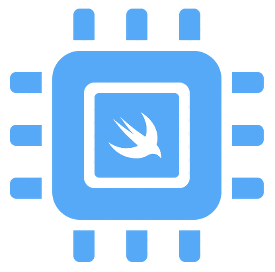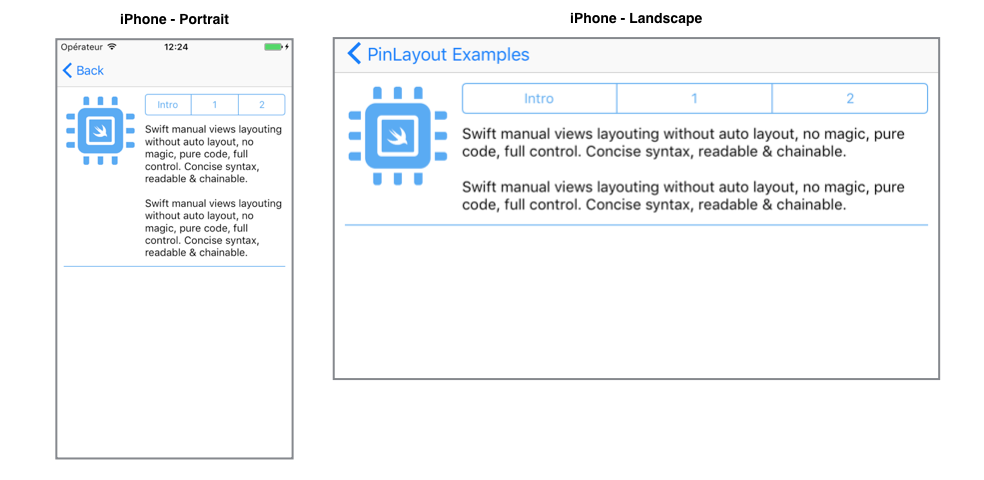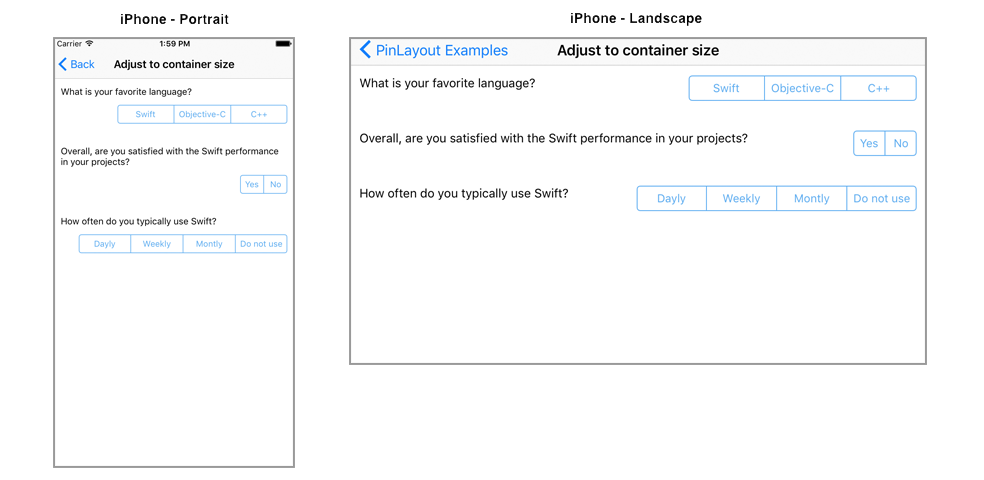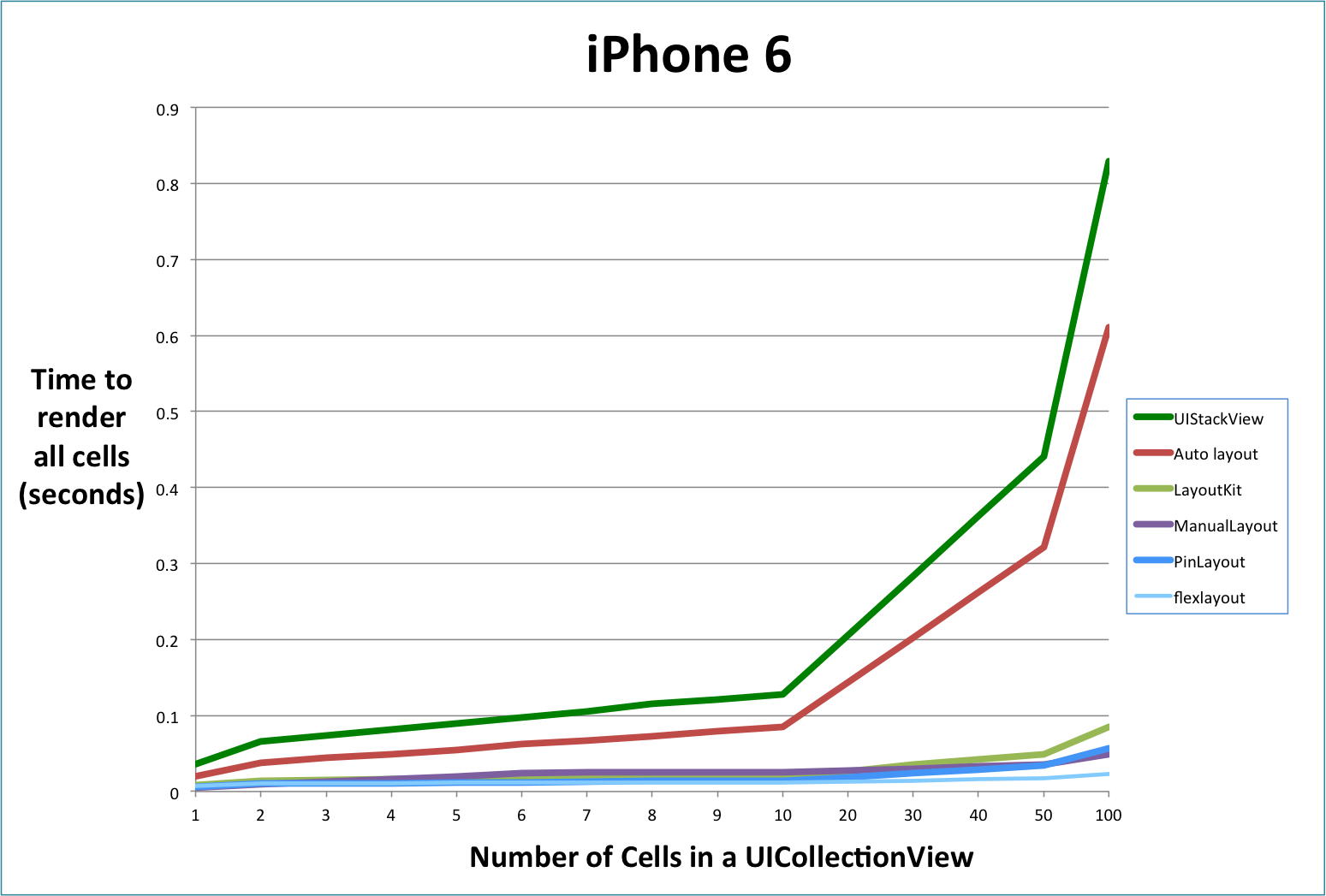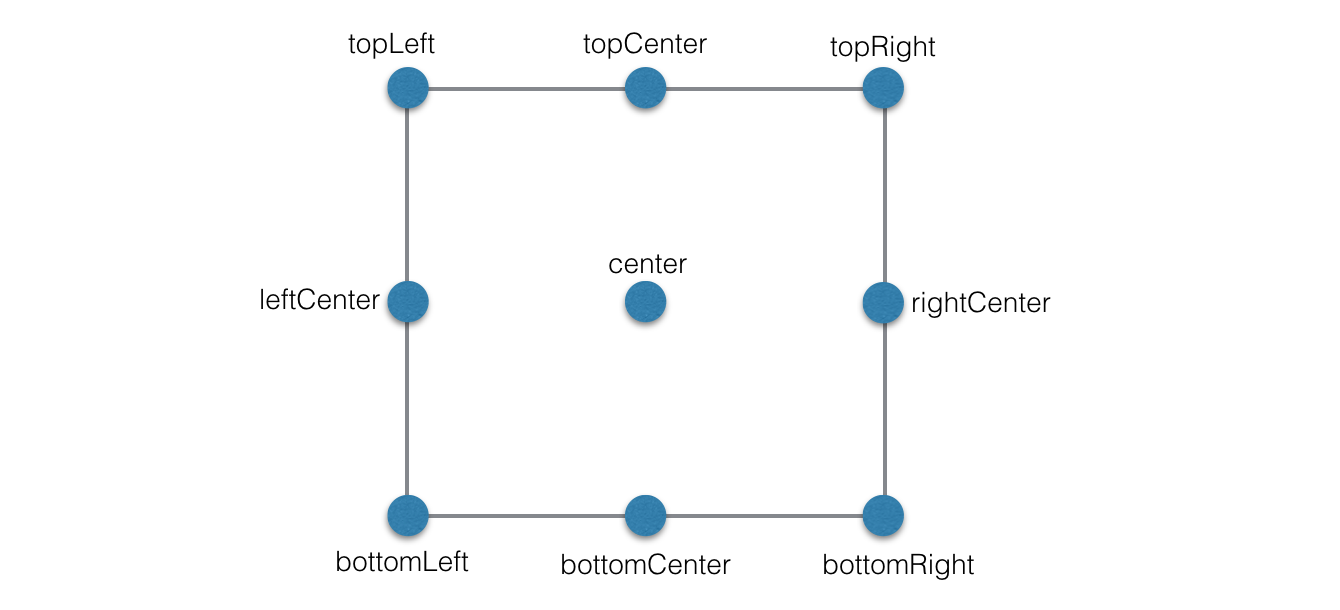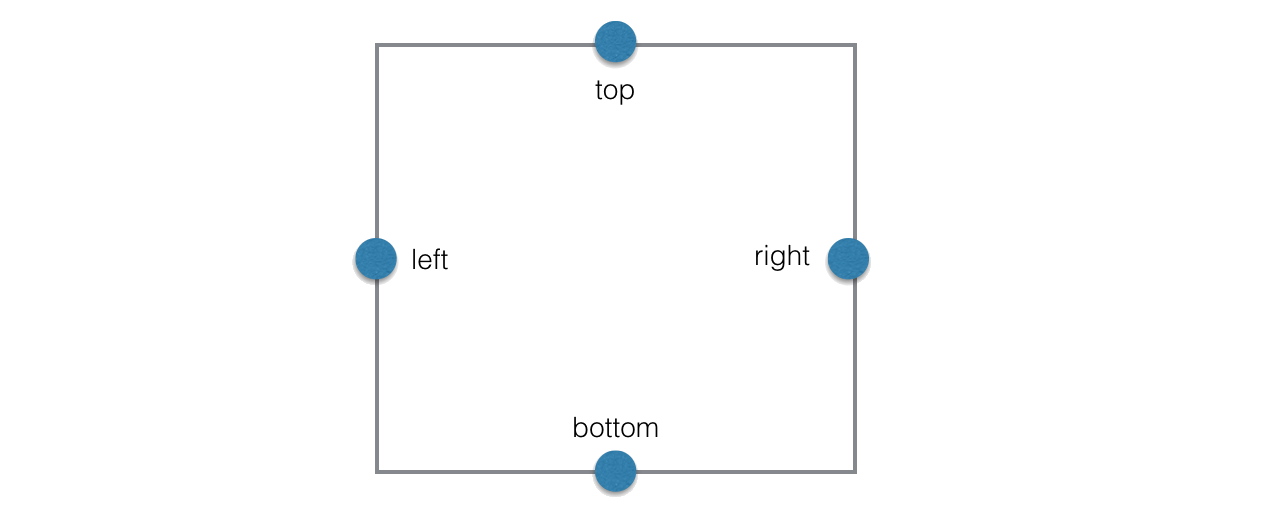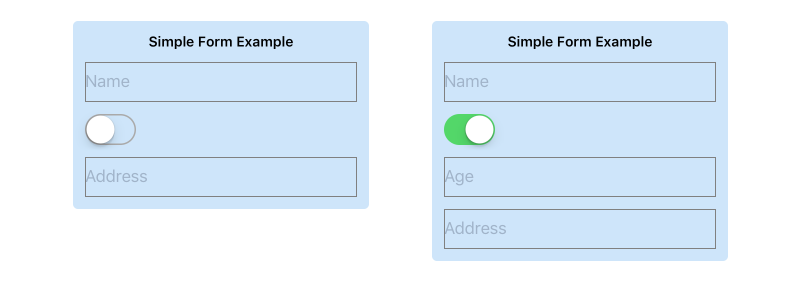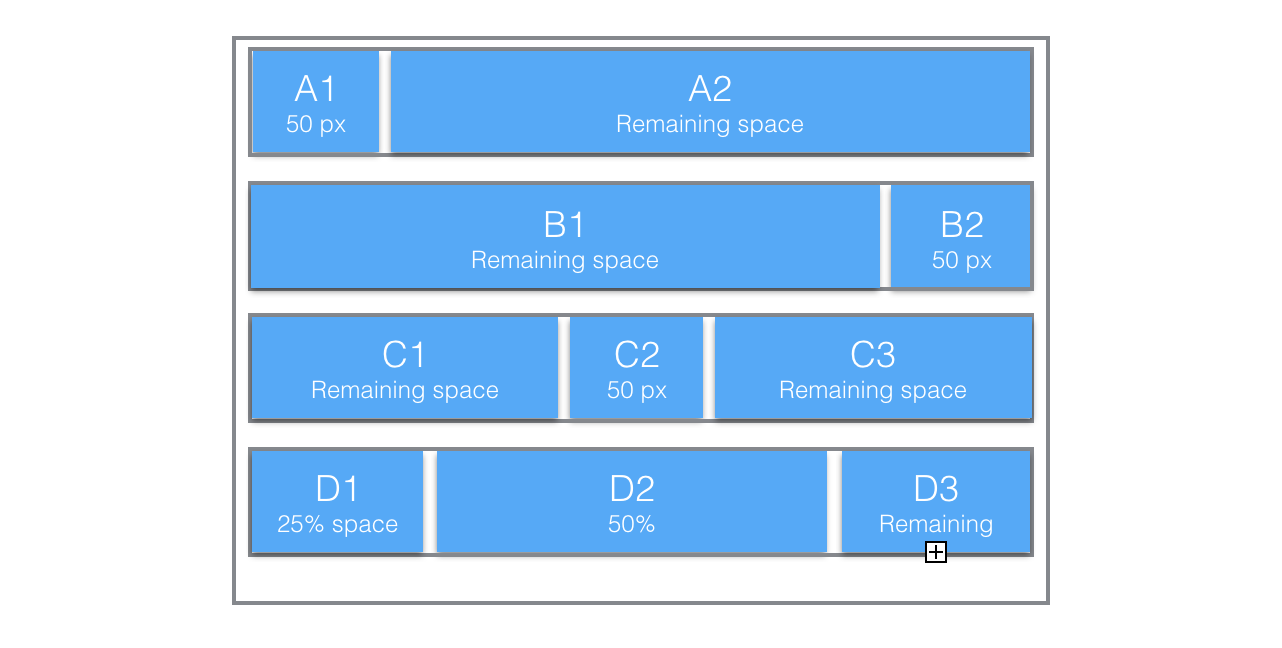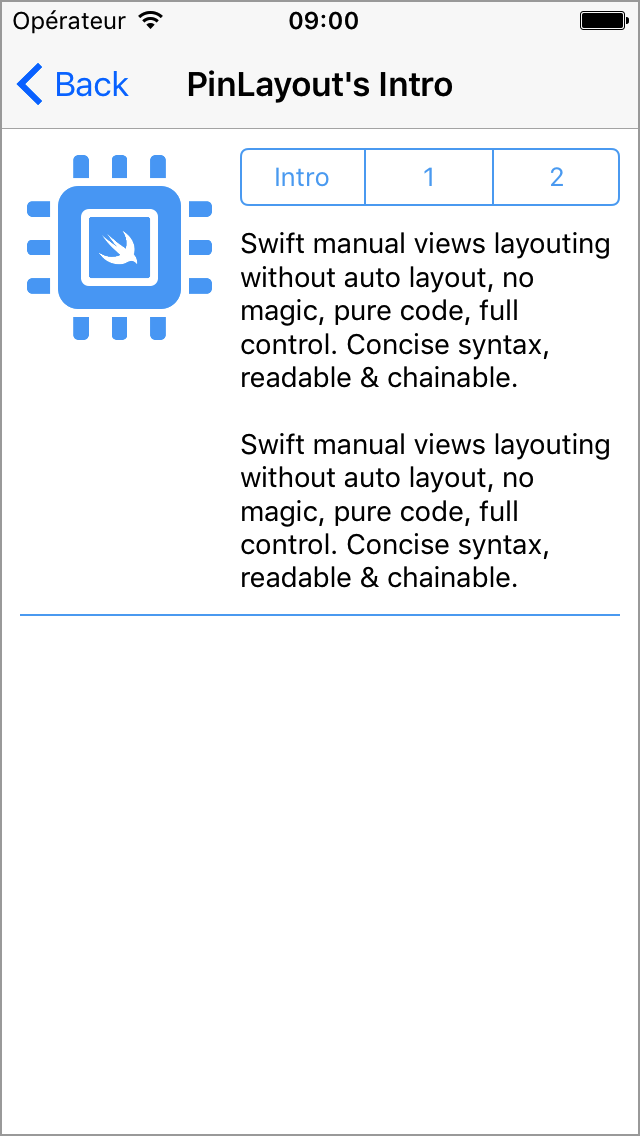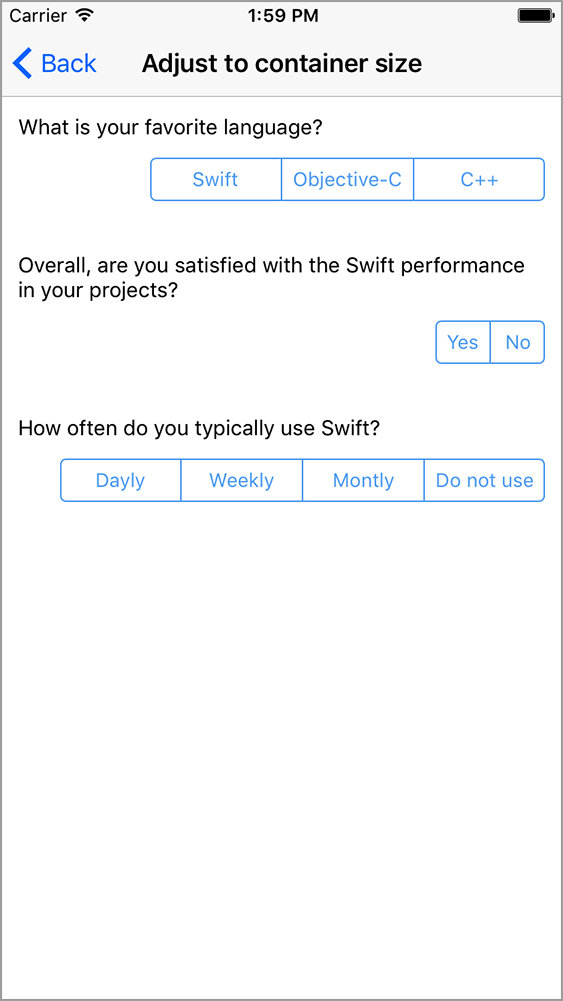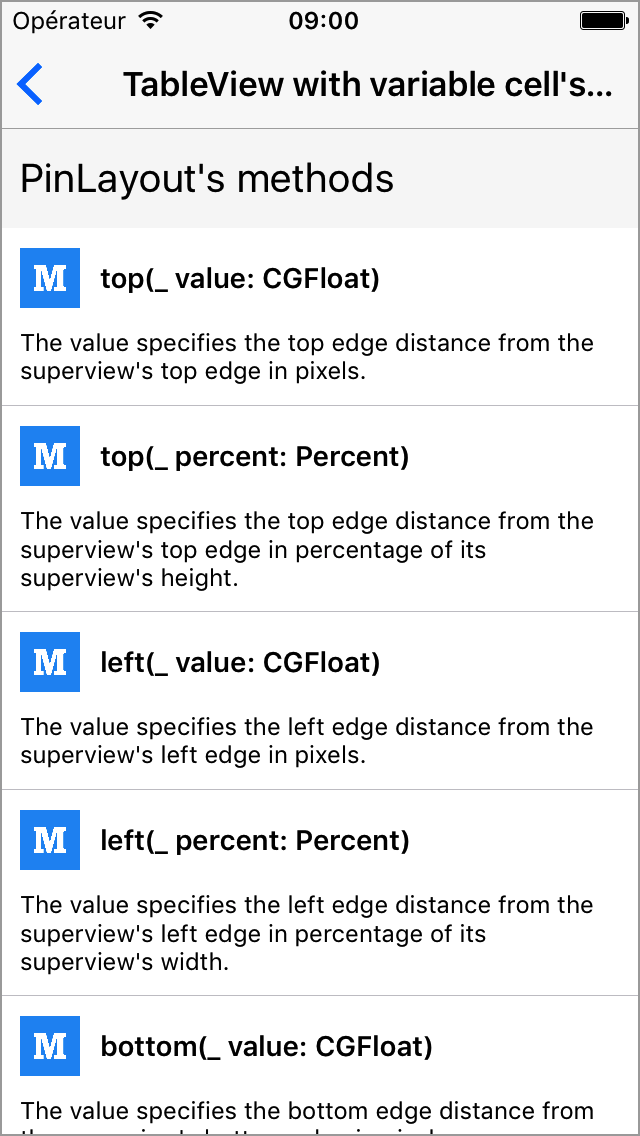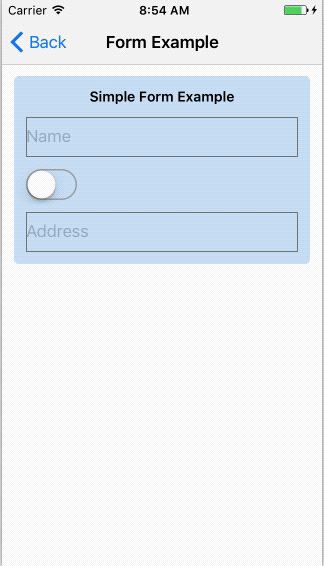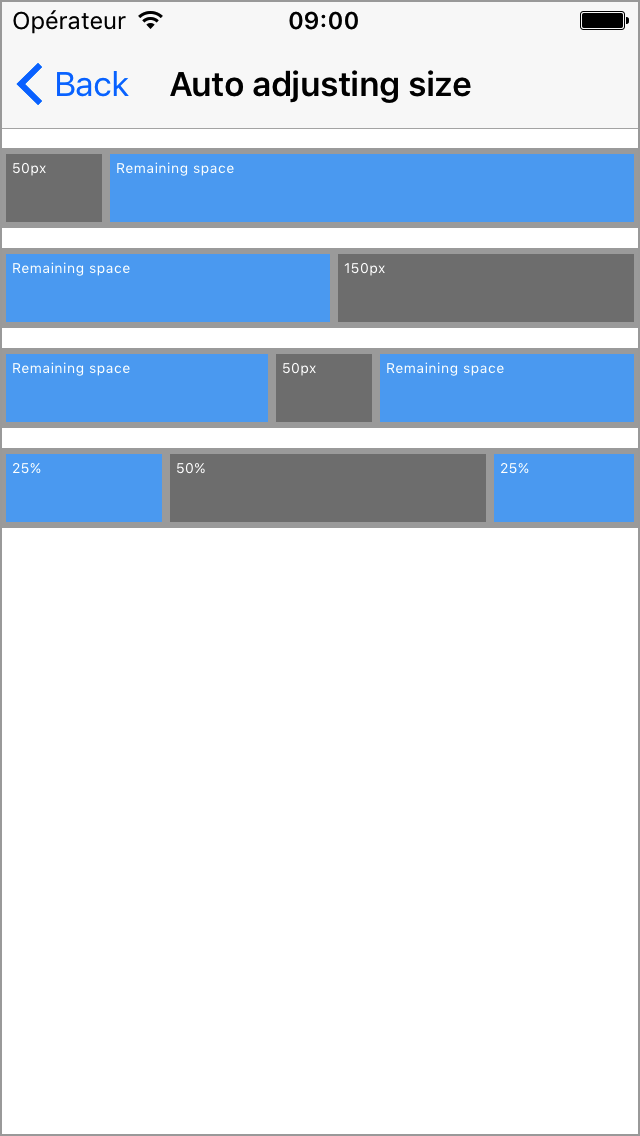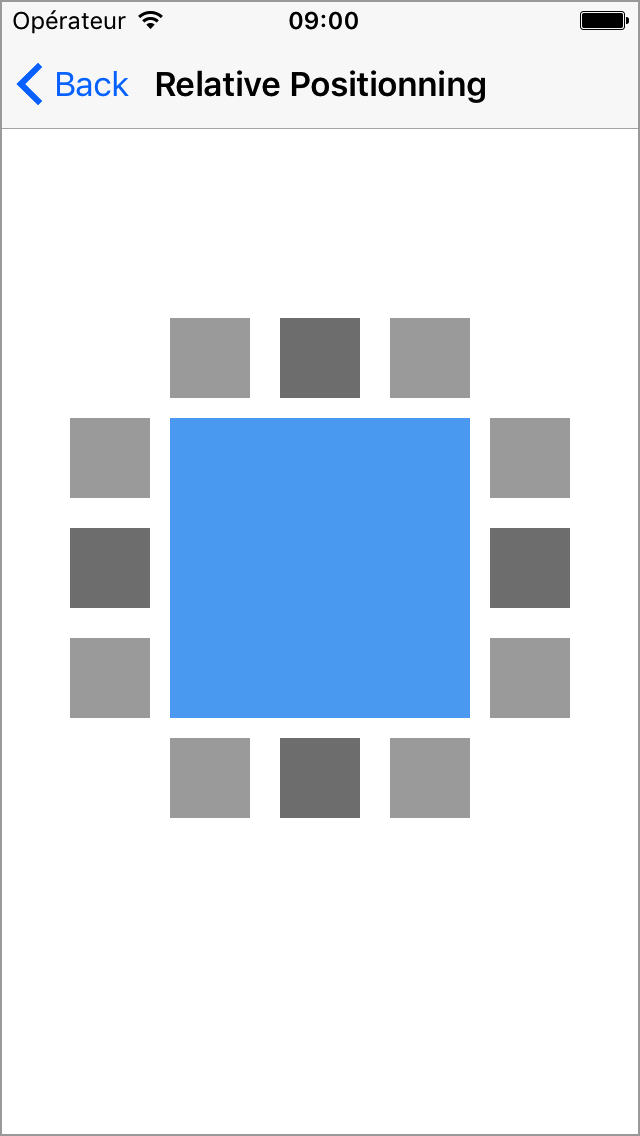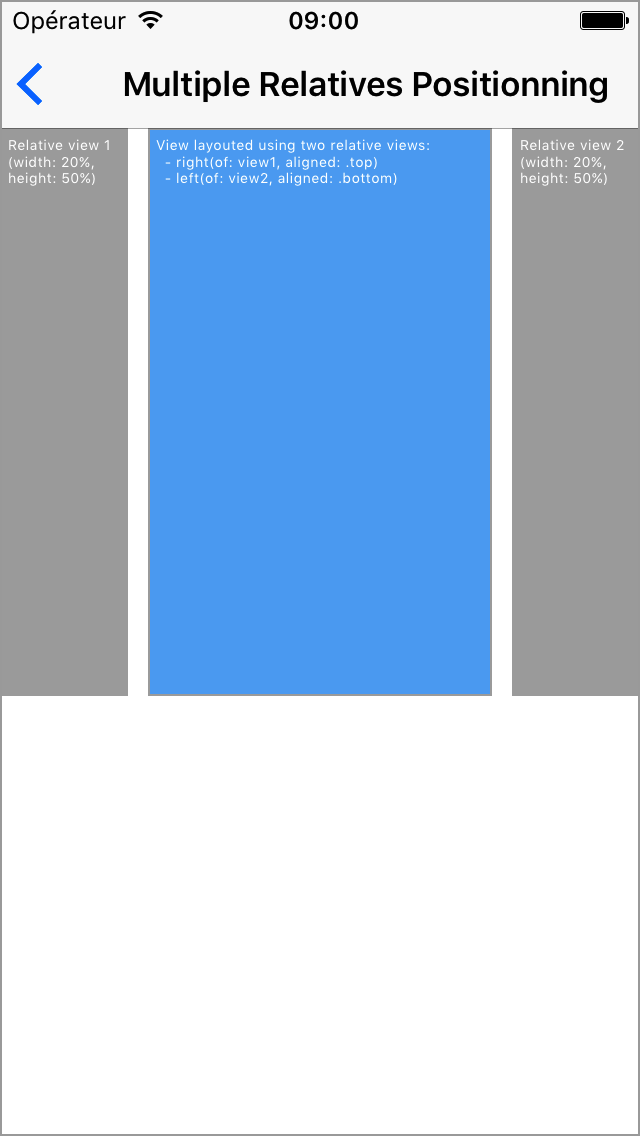Extremely Fast views layouting without auto layout. No magic, pure code, full control and blazing fast. Concise syntax, intuitive, readable & chainable.
"No Auto layout constraints attached"
- iOS 8.0+ / tvOS 9.0+
- Xcode 8.0+ / Xcode 9.0
- Swift 3.0+ / Swift 4.0
- Introduction examples
- PinLayout principles and philosophy
- Performance
- Documentation
- Examples App
- Installation
- FAQ
- Comments, ideas, suggestions, issues, ....
📌 PinLayout is actively updated. So please come often to see latest changes. You can also Star it to be able to retrieve it easily later.
PinLayout is a companion of FlexLayout. They share a similar syntax and method names. FlexLayout is a flexbox implementation.
- A view can be layouted using PinLayout, FlexLayout, or both!
- FlexLayout it is particularly useful in situations where you need to layouts many views but don't require the PinLayout's finest control nor complex animations.
- A view layouted using PinLayout can be embedded inside a FlexLayout's container and reversely. You choose the best layout framework for your situation.
This example layout an image, a UISegmentedControl, a label and a line separator. This example adjusts its content to match the device's size and orientation changes.
- UIImageView's size is 100x100 and layouted below the UINavigationBar with a margin of 10 pixels all around.
- UISegmentedControl is at the right of the logo image, use the remaining horizontal space with a left and right margin of 20 pixels.
- UILabel is below the UISegmentedControl with a top margin of 10 pixels. It's width matched the UISegmentedControl's width. The label is multiline, so its height must be adjusted to fit its width.
- Separator is below the UIImageView and the UILabel, i.e. below the tallest one. The separator has a top margin of 10 pixels, left-aligned to the UIImageView and right-aligned to the UISegmentedControl.
override func layoutSubviews() {
super.layoutSubviews()
logo.pin.top().left().size(100).margin(10)
segmented.pin.right(of: logo, aligned: .top).right().marginHorizontal(10)
textLabel.pin.below(of: segmented, aligned: .left).right().marginTop(10).marginRight(10).fitSize()
separatorView.pin.below(of: [logo, textLabel], aligned: .left).right(to: segmented.edge.right).marginTop(10)
}📌 4 views, 4 lines!
📌 PinLayout doesn't use auto layout constraints, it is a framework that manually layout views. For that reason you need to update the layout inside either UIView.layoutSubviews() or UIViewController.viewDidLayoutSubviews() to handle container size's changes, including device rotation. You'll also need to handle UITraitCollection changes for app's that support multitasking. In the example above PinLayout's commands are inside UIView's layoutSubviews() method.
📌 This example is available in the Examples App. See example complete source code
This example shows how easily PinLayout can adjust its layout based on the view's container size.
- If the container's width is smaller than 500 pixels, the label takes the full width and the UISegmentedControl is placed below it.
- If the container's width is greater or equal to 500 pixels, the UISegmentedControl is at the top-right corner and the label takes the remaining horizontal space.
let margin: CGFloat = 12
if frame.width < 500 {
textLabel.pin.top().left().right().margin(margin).fitSize()
segmentedControl.pin.below(of: textLabel).right().margin(margin)
} else {
segmentedControl.pin.top().right().margin(margin)
textLabel.pin.top().left().left(of: segmentedControl).margin(margin).fitSize()
}📌 Would it be easier using auto layout?
📌 This example is available in the Examples App. See example complete source code
-
Manual layouting (doesn't rely on auto layout).
-
PinLayout exist to be simple and fast as possible! In fact, it is fast as manual layouting. See performance results below.
-
Full control: You're in the middle of the layout process, no magic black box.
- You can add conditions (if/switch/guard/...) related to the device orientation, device type, traitCollection, animations, ...
- You can add iterations and enumerations (for/while/forEach/...)
-
Layout one view at a time. Make it simple to code and debug.
-
Concise syntax. Layout most views using a single line.
-
Support left to right (LTR) and right to left (RTL) languages.
-
Stateless
- PinLayout doesn’t add any stored properties to UIViews. It simply computes the UIView.frame property, one view at a time.
- Since it is stateless, it can be used with any other layout framework without conflicts. Each view can use the layout system that better suit it (PinLayout, constraints, flexbox, grids, …) A view can be layouted using PinLayout and later with another method/framework.
-
No Auto layout and constraints
- Constraints are verbose and hard for a human brains to understand when there are many views implicated, even with sugar-syntax frameworks.
- PinLayout positions views as a designer would explain it (eg: “The TextField is below the Label, aligned left, and is its width matches the other view’s width“).
- No priorities, simply layout views in the order that makes sense. No priorities required.
-
Before applying the new sets of attributes, PinLayout always start with the view’s current frame. So it’s possible to set the view’s size during the initialization (ex: view.pin.width(100).height(200)), and later only position the view (ex: view.pin.top(10).left(20)). This makes PinLayout really animation friendly.
-
Not too intrusive. PinLayout only adds three properties to existing iOS classes:
UIView.pin,UIView.anchorandUIView.edge -
Minimize as much as possible calculations and constants when layouting views. But it is always possible to add advanced computation if required.
-
Method's name match as much as possible other layout frameworks, including FlexLayout/flexbox, CSS, React Native, …
- margin, marginHorizontal, marginVertical, marginTop, marginLeft, marginBottom, marginRight
- top, left, bottom, right, width, height
- As in CSS and flexbox, right and bottom coordinates are offset from container view's right and bottom edges.
-
Shorter possible commands to layout views, but keeping English phrasing almost valid.
📌 PinLayout doesn't support Auto layout nor Storyboard. Interesting quote:
"UIKit Auto Layout and InterfaceBuilder are not supported by Texture. It is worth noting that both of these technologies are not permitted in established and disciplined iOS development teams, such as at Facebook, Instagram, and Pinterest"
PinLayout's performance has been measured using the nice LayoutKit benchmark. PinLayout and FlexLayout has been added to this benchmark to compare their performance.
As you can see in the following chart, PinLayout and FlexLayout and performance are faster or equal to manual layouting, and between 12x and 16x faster than auto layout, and this for all types of iPhone (5/6/6S/7)
These results also mean that PinLayout is by far faster than any layout frameworks built over auto layout.
See here a more complete details, results and explanation of the benchmark.
Tested on a iPhone 6 iOS 10.3.2
PinLayout supports left-to-right (LTR) and right-to-left (RTL) languages.
Every method/properties with a name containing left/right, has RTL enabled equivalent methods with a name containing start/end.
Using start or end methods, you can position views without having to think about whether your item will show up on the left or the right side of the screen (depending on the person’s language
📌 In this documentation all methods that support RTL languages are marked using the following icon
Method:
-
Pin.layoutDirection(direction: LayoutDirection)↔️ :
Set the PinLayout layout direction. Note that this set PinLayout's layout direction globaly. By default PinLayout use the left-to-right direction.Layout direction modes:
.ltr: Layout views from left to right. (Default).rtl: Layout views from right to left..auto: Layout views based onUIView.userInterfaceLayoutDirection(for: semanticContentAttribute)(>= iOS 9) orUIApplication.shared.userInterfaceLayoutDirection(< iOS 9). If you want to control the layout direction individually for each views, you should use this mode and control the view's layout direction usingUIView.userInterfaceLayoutDirectionproperty.
RTL full documentation coming soon....
📌 See the RTL enabled "Introduction example" source code. This example is available in the Examples App
PinLayout can position a view’s edge relative to its superview edges.
Methods:
top(_ value: CGFloat)
The value specifies the top edge distance from the superview's top edge in pixels.top(_ percent: Percent)
The value specifies the top edge distance from the superview's top edge in percentage of its superview's height.left(_ value: CGFloat)
The value specifies the left edge distance from the superview's left edge in pixels.left(_ percent: Percent)
The value specifies the left edge distance from the superview's left edge in percentage of its superview's width.bottom(_ value: CGFloat)
The value specifies the bottom edge distance from the superview's bottom edge in pixels.bottom(_ percent: Percent)
The value specifies the bottom edge distance from the superview's bottom edge in percentage of its superview's height.right(_ value: CGFloat)
The value specifies the right edge distance from the superview's right edge in pixels.right(_ percent: Percent)
The value specifies the right edge distance from the superview's right edge in percentage of its superview's width.hCenter(_ value: CGFloat)
The value specifies the horizontal center distance from the superview's left edge in pixels.hCenter(_ percent: Percent)
The value specifies the horizontal center distance from the superview's left edge in percentage of its superview's width.vCenter(_ value: CGFloat)
The value specifies the vertical center distance from the superview's top edge in pixels.vCenter(_ percent: Percent)
The value specifies the vertical center distance from the superview's top edge in percentage of its superview's height.start(_ value: CGFloat)↔️
In LTR direction the value specifies the left edge distance from the superview's left edge in pixels.
In RTL direction the value specifies the right edge distance from the superview's right edge in pixels.start(_ percent: Percent)↔️
In LTR direction the value specifies the left edge distance from the superview's left edge in percentage of its superview's width.
In RTL direction the value specifies the right edge distance from the superview's right edge in percentage of its superview's width.end(_ value: CGFloat)↔️
In LTR direction the value specifies the right edge distance from the superview's right edge in pixels.
In RTL direction the value specifies the left edge distance from the superview's left edge in pixels.end(_ percent: Percent)↔️
In LTR direction the value specifies the right edge distance from the superview's right edge in percentage of its superview's width.
In RTL direction the value specifies the left edge distance from the superview's left edge in percentage of its superview's width.
view.pin.top(20).left(20)
view.pin.top(25%).hCenter(0)
view.pin.left(12).vCenter(100)
view.pin.start(20).end(20)This example layout the view A to fit its superview frame with a margin of 10 pixels. It pins the top, left, bottom and right edges.

viewA.pin.top(10).bottom(10).left(10).right(10)Another possible solution using other PinLayout's methods (more details later):
view.pin.top().bottom().left().right().margin(10)PinLayout also has a shorter version that pins a view’s edge directly on its superview's corresponding edge.
Methods:
top()
Position the view top edge directly on its superview top edge. Similar to callingtop(0).left()
Position the view left edge directly on its superview left edge. Similar to callingleft(0).bottom()
Position the view bottom edge directly on its superview top edge. Similar to callingbottom(0).right()
Position the view right edge directly on its superview right edge. Similar to callingright(0).start()↔️
Position the view left edge directly on its superview left edge in LTR direction or right edge directly on its superview right edge in RTL direction. Similar to callingstart(0).end()↔️
Position the view right edge directly on its superview right edge in LTR direction or left edge directly on its superview left edge in RTL direction. Similar to callingend(0).hCenter()
Position the view horizontal center directly on its superview horizontal center. Similar to callinghCenter(superview.frame.width / 2).vCenter()
Position the view vertical center directly on its superview vertical center. Similar to callinghCenter(superview.frame.height / 2).
view.pin.top().left()
view.pin.bottom().right()
view.pin.hCenter().vCenter()
view.pin.start().end()This example is similar to the previous example, but pins edges directly on superview’s edges. It will layout the view A to fit its superview frame with a margin of 10 pixels.
viewA.pin.top().left().bottom().right().margin(10)PinLayout adds anchors properties to UIViews. These properties are used to reference other view’s anchors.
PinLayout UIView’s anchors:
UIView.anchor.topLeftUIView.anchor.topCenterUIView.anchor.topRightUIView.anchor.topStart↔️ UIView.anchor.topEnd↔️ UIView.anchor.centerLeftUIView.anchor.centersUIView.anchor.centerRightUIView.anchor.centerStart↔️ UIView.anchor.centerEnd↔️ UIView.anchor.bottomLeftUIView.anchor.bottomCenterUIView.anchor.bottomRightUIView.anchor.bottomStart↔️ UIView.anchor.bottomEnd↔️
PinLayout can use anchors to position view’s related to other views.
Following methods position the corresponding view anchor on another view’s anchor.
Methods:
topLeft(to anchor: Anchor)topCenter(to anchor: Anchor)topRight(to anchor: Anchor)topStart(to anchor: Anchor)↔️ topEnd(to anchor: Anchor)↔️ centerLeft(to anchor: Anchor)center(to anchor: Anchor)centerRight(to anchor: Anchor)centerStart(to anchor: Anchor)↔️ centerEnd(to anchor: Anchor)↔️ bottomLeft(to anchor: Anchor)bottomCenter(to anchor: Anchor)bottomRight(to anchor: Anchor)bottomStart(to anchor: Anchor)↔️ bottomEnd(to anchor: Anchor)↔️
📌 These methods can pin a view’s anchor to any other view's anchor, even if don't have the same direct superview! It works with any views that have at some point the same ancestor.
view.pin.topCenter(to: view1.anchor.bottomCenter)
view.pin.topLeft(to: view1.anchor.topLeft).bottomRight(to: view1.anchor.center)Layout using an anchor. This example pins the view B topLeft anchor on the view A topRight anchor.
viewB.pin.topLeft(to: viewA.anchor.topRight)Layout using multiple anchors.
It is also possible to combine two anchors to pin the position and the size of a view. The following example will position the view C between the view A and B with horizontal margins of 10px.
viewC.pin.topLeft(to: viewA.anchor.topRight)
.bottomRight(to: viewB.anchor.bottomLeft).marginHorizontal(10)PinLayout also has a shorter version that pins a view's anchor directly on its corresponding superview’s anchor.
The following methods position the corresponding view's anchor on another view’s anchor.
Methods:
topLeft()topCenter()topRight()topStart()↔️ topEnd()↔️ centerLeft()center()centerRight()centerStart()↔️ centerEnd()↔️ bottomLeft()bottomCenter()bottomRight()bottomStart()↔️ bottomEnd()↔️
For example .topRight() will pin the view’s topRight anchor on its superview’s topRight anchor..
viewA.pin.topRight()This is equivalent to:
viewA.pin.topRight(to: superview.pin.topRight)PinLayout adds edges properties to UIViews. These properties are used to reference other view’s edges.
PinLayout UIView’s edges:
UIView.edge.topUIView.edge.leftUIView.edge.bottomUIView.edge.rightUIView.edge.start↔️ UIView.edge.end↔️
PinLayout has methods to attach a UIView's edge (top, left, bottom, right, start or end edge) to another view’s edge.
Methods:
top(to edge: VerticalEdge)left(to: edge: HorizontalEdge)bottom(to edge: VerticalEdge)right(to: edge: HorizontalEdge)start(to: edge: HorizontalEdge)↔️ end(to: edge: HorizontalEdge)↔️
📌 These methods can pin a view’s edge to any other view's edge, even if don't have the same direct superview! It works with any views that have at some point the same ancestor.
view.pin.left(to: view1.edge.right)
view.pin.left(to: view1.edge.right).top(to: view2.edge.right)Layout using an edge.
The following example will layout the view B left edge on the view A right edge. It only changes the view B left coordinate.
viewB.pin.left(to: viewA.edge.right)PinLayout also has methods to position relative to other views. The view can be layouted relative to one or many relative views.
Methods:
-
above(of: UIView)
above(of: [UIView])
Position the view above the specified view(s). One or many relative views can be specified. This method is similar to pinning the view’s bottom edge. -
below(of: UIView)
below(of: [UIView])
Position the view below the specified view(s). One or many relative views can be specified. This method is similar to pinning the view’s top edge. -
left(of: UIView)
left(of: [UIView])
Position the view left of the specified view(s). One or many relative views can be specified. This method is similar to pinning the view’s right edge. -
right(of: UIView)
right(of: [UIView])
Position the view right of the specified view(s). One or many relative views can be specified. This method is similar to pinning the view’s left edge. -
before(of: UIView)↔️
before(of: [UIView])↔️
In LTR direction the view is positionned at the left of the specified view(s). In RTL direction the view is positionned at the right. One or many relative views can be specified. -
after(of: UIView)↔️
after(of: [UIView])↔️
In LTR direction the view is positionned at the right of the specified view(s). In RTL direction the view is positionned at the left. One or many relative views can be specified.
📌 Multiple relative views: If for example a call to `below(of: [...]) specify multiple relative views, the view will be layouted below ALL these views.
📌 These methods set the position of a view's edge: top, left, bottom or right. For example below(of ...) set the view's top edge, `right(of ...) set the view's left edge, ...
📌 These methods can pin a view’s relative to any views, even if don't have the same direct superview! It works with any views that have at some point the same ancestor.
view.pin.left(of: view2)
view.pin.below(of: [view2, view3, view4])
view.pin.left(of: view1).above(of: view2).right(of: view4).below(of: view3)
view.pin.after(of: view4).before(of: view1).below(of: view3)The following example will position the view C between the view A and B with margins of 10px using relative positioning methods.
viewC.pin.top().left(of: viewA).right(of: viewB).margin(10)This is an equivalent solution using edges:
viewC.pin.top().left(to: viewA.edge.right).right(to: viewB.edge.left).margin(10)This is also an equivalent solution using relative positioning and alignment explained in the next section:
viewC.pin.left(of: viewA, aligned: .top).right(of: viewB, aligned: top).marginHorizontal(10)PinLayout also has methods to position relative to other views but with also the ability to specify the alignment. The view can be layouted relative to one or many relative views.
Methods:
-
above(of: UIView, aligned: HorizontalAlignment)
above(of: [UIView], aligned: HorizontalAlignment)
Position the view above the specified view(s) and aligned it using the specified HorizontalAlignment. One or many relative views can be specified. This method is similar to pinning one view’s anchor: bottomLeft, bottomCenter or bottomRight. -
below(of: UIView, aligned: HorizontalAlignment)
below(of: [UIView], aligned: HorizontalAlignment)
Position the view below the specified view(s) and aligned it using the specified HorizontalAlignment. One or many relative views can be specified. This method is similar to pinning one view’s anchor: topLeft, topCenter or topRight. -
left(of: UIView, aligned: VerticalAlignment)
left(of: [UIView], aligned: HorizontalAlignment)
Position the view left of the specified view(s) and aligned it using the specified VerticalAlignment. One or many relative views can be specified. This method is similar to pinning one view’s anchor: topRight, centerRight or bottomRight. -
right(of: UIView, aligned: VerticalAlignment)
right(of: [UIView], aligned: HorizontalAlignment)
Position the view right of the specified view(s) and aligned it using the specified VerticalAlignment. One or many relative views can be specified. This method is similar to pinning one view’s anchor: topLeft, centerLeft or bottomLeft. -
before(of: UIView, aligned: HorizontalAlignment)↔️
before(of: [UIView], aligned: HorizontalAlignment)↔️
In LTR direction the view is positionned at the left of the specified view(s). In RTL direction the view is positionned at the right. One or many relative views can be specified. -
after(of: UIView, aligned: HorizontalAlignment)↔️
after(of: [UIView], aligned: HorizontalAlignment)↔️
In LTR direction the view is positionned at the right of the specified view(s). In RTL direction the view is positionned at the left. One or many relative views can be specified.
How alignment is applied:
HorizontalAlignment.left: The view's left edge will be aligned to the left most relative view.HorizontalAlignment.center: The view's hCenter edge will be aligned with the average hCenter of all relative views.HorizontalAlignment.right: The view's right edge will be aligned to the right most relative view.HorizontalAlignment.start↔️ :
In LTR direction the view's left edge will be aligned to the left most relative view.
In RTL direction the view's right edge will be aligned to the right most relative view.HorizontalAlignment.end↔️ :
In LTR direction the view's right edge will be aligned to the right most relative view.
In RTL direction the view's left edge will be aligned to the right most relative view.VerticalAlignment.top: The view's top edge will be aligned to the top most relative view.VerticalAlignment.center: The view's vCenter edge will be aligned with the average vCenter of all relative views.VerticalAlignment.bottom: The view's bottom edge will be aligned to the bottom most relative view.
📌 Multiple relative views: If for example a call to `below(of: [...], aligned:) specify multiple relative views, the view will be layouted below ALL these views. The alignment will be applied using all relative view
📌 These methods set the position of a view's anchor: topLeft, topCenter, topRight, centerLeft, .... For example below(of ..., aligned: .right) set the view's topRight anchor, `right(of ..., aligned: .center) set the view's centerLeft anchor, ...
📌 These methods set the position of a view's edge: top, left, bottom or right. For example below(of ...) set the view's top edge, `right(of ...) set the view's left edge, ...
view.pin.above(of: view2, aligned: .left)
view.pin.below(of: [view2, view3, view4], aligned: .left)
view.pin.left(of: view2, aligned: .top).right(of: view3, aligned: .bottom)The following example layout the view B below the view A aligned on its center.
viewB.pin.below(of: viewA, aligned: .center)This is an equivalent solution using anchors:
viewB.pin.topCenter(to: viewA.anchor.bottomCenter)The following example layout the view A below the UIImageView and the UILabel. View A should be left aligned to the UIImageView and right aligned to the UILabel, with a top margin of 10 pixels.
a.pin.below(of: [imageView, label], aligned: .left).right(to: label.edge.right).marginTop(10)This is an equivalent solutions using other methods:
let maxY = max(imageView.frame.maxY, label.frame.maxY) // Not so nice
a.pin.top(maxY).left(to: imageView.edge.left).right(to: label.edge.right).marginTop(10)All PinLayout's relative methods can accept an array of UIViews (ex: below(of: [UIView])). Using these methods it's possible to filter the list of relative UIViews before the list is used by PinLayout.
PinLayout has a filter method called visible that can be used to layout a view related to only visible views. This can be really useful when some views may be visible or hidden depending on the situation.
The following example contains a UISwitch. Below a UITextField that is visible only when the UISwitch is set to ON. And then follow another UITextField. This example use the visible(views: [UIView]) -> [UIView] filter method that returns only views with UIView.isHidden set to false or UIView.alpha greater than 0.
formTitleLabel.pin.topCenter().marginTop(margin)
nameField.pin.below(of: formTitleLabel).left().right().height(40).margin(margin)
ageSwitch.pin.below(of: nameField).left().right().height(40).margin(margin)
ageField.pin.below(of: ageSwitch).left().right().height(40).margin(margin)
// Layout the Address UITextField below the last visible view, either ageSwitch or ageField.
addressField.pin.below(of: visibles([ageSwitch, ageField])).left().right().height(40).margin(margin)Note that this example is extracted from the Form example, see Examples App
PinLayout has methods to set the view’s height and width.
Methods:
width(_ width: CGFloat)
width(percent: Percent)
The value specifies the view's width in pixels or in percentage of its superview. The value must be non-negative.width(of view: UIView)
Set the view’s width to match the referenced view’s width.height(_ height: CGFloat)
height(percent: Percent)
The value specifies the view's height in pixels or in percentage of its superview. The value must be non-negative.height(of view: UIView)
Set the view’s height to match the referenced view’s heightsize(_ size: CGSize)
size(_ percent: Percent)
The value specifies view's width and the height in pixels or in percentage of its superview. Values must be non-negative.size(_ sideLength: CGFloat)
The value specifies the width and the height of the view in pixels, creating a square view. Values must be non-negative.size(of view: UIView)
Set the view’s size to match the referenced view’s size
📌 width/height/size have a higher priority than edges and anchors positioning.
view.pin.width(50%)
view.pin.width(100)
view.pin.width(of: view1)
view.pin.height(100%)
view.pin.height(200)
view.pin.size(of: view1)
view.pin.size(50%)
view.pin.size(250)Method:
-
fitSize()
fitSize()is the equivalent of calling sizeThatFits(_: CGSize) once PinLayout has determined the view's size and has applied margins.fitSize()is applied only if at least the width or the height (or both) can be determined.The method was previously named
sizeToFit(), but it was creating confusion with the already existingUIView.sizeToFit()method.
// Adjust the label's size based on a width of 200 pixels
label.pin.width(200).fitSize()
// Adjust the label's size based on the computed view's width
label.pin.left().right().fitSize()
// WRONG, neither the width nor the height can be determined, fitSize() won't be applied
label.pin.top().left().fitSize()The following example layout the UILabel on the right side of the UIImageView with a margin of 10px all around and also adjust the UILabel’t height to fit the text size. Note on the result that the UILabel’s height has changed to fit its content.
label.pin.right(of: image, aligned: .top).right().marginHorizontal(10).fitSize()PinLayout has methods to set the view’s minimum and maximum width, and minimum and maximum height.
Methods:
-
minWidth(_ width: CGFloat)
minWidth(_ percent: Percent)
The value specifies the view's minimum width of the view in pixels or in percentage of its superview. The value must be non-negative. -
maxWidth(_ width: CGFloat)
maxWidth(_ percent: Percent)
The value specifies the view's maximum width of the view in pixels or in percentage of its superview. The value must be non-negative. -
minHeight(_ height: CGFloat)
minHeight(_ percent: Percent)
The value specifies the view's minimum height of the view in pixels or in percentage of its superview. The value must be non-negative. -
maxHeight(_ height: CGFloat)
maxHeight(_ percent: Percent)
The value specifies the view's maximum height of the view in pixels or in percentage of its superview. The value must be non-negative.
view.pin.left(10).right(10).maxWidth(200)
view.pin.width(100%).maxWidth(250)
view.pin.top().bottom().maxHeight(100)
view.pin.top().height(50%).maxHeight(200)📌 minWidth/maxWidth & minHeight/maxHeight have the highest priority. Higher than sizes (width/height/size) and edges positioning (top/left/bottom/right). Their values are always fullfilled.
This example layout a view 20 pixels from the top, and horizontally from left to right with a maximum width of 200 pixels. If the superview is smaller than 200 pixels, the view will take the full horizontal space, but for a larger superview, the view will be centered.
viewA.pin.top(20).hCenter().width(100%).maxWidth(200)This is an equivalent solutions using the justify() method. This method is explained in the next section:
viewA.pin.top(20).left().right().maxWidth(200).justify(.center)Methods:
-
justify(_ : HorizontalAlign)
Justify the view horizontally. This method justifies horizontally a view in situations where the left, right and the width has been set (using either width/minWidth/maxWidth). In this situation, the view may be smaller than the space available between the left and the right edges. A view can be justified left, center, right, start*, end*. -
align(_ : VerticalAlign)
Align the view vertically. This method aligns vertically a view in situations where the top, bottom and the height has been set (using either height/minHeight/maxHeight). In this situation, the view may be smaller than the space available between the top and the bottom edges. A view can be aligned top, center or bottom.
view.pin.left().right().marginHorizontal(20).maxWidth(200).justify(.center)
view.pin.below(of: A).above(of: B).width(40).align(.center)This example layout a view between its superview left and right edges with a maximum size of 200 pixels. Without the usage of the justify(:HorizontalAlign) method, the view will be justified on the left:
viewA.pin.left().right().maxWidth(200)The same example, but using justify(.center):
viewA.pin.left().right().maxWidth(200).justify(.center)And finally using justify(.right):
viewA.pin.left().right().maxWidth(200).justify(.right)This example centered horizontally the view B in the space remaining at the right of the view A. The view B has a width of 100 pixels.
viewB.pin.left(of: viewA, aligned: .top).right().width(100).justify(.center)PinLayout applies margins similar to CSS.
PinLayout has methods to apply margins.
Methods:
marginTop(_ value: CGFloat)marginLeft(_ value: CGFloat)marginBottom(_ value: CGFloat)marginRight(_ value: CGFloat)marginStart(_ value: CGFloat)↔️ marginEnd(_ value: CGFloat)↔️ marginHorizontal(_ value: CGFloat)marginVertical(_ value: CGFloat)margin(_ value: CGFloat)margin(_ vertical: CGFloat, _ horizontal: CGFloat)margin(_ top: CGFloat, _ horizontal: CGFloat, _ bottom: CGFloat)margin(_ top: CGFloat, _ right: CGFloat, _ bottom: CGFloat, _ left: CGFloat)
view.pin.top().left().margin(20)
view.pin.bottom().marginBottom(20)
view.pin.left().right().marginHorizontal(20)
view.pin.top().bottom().left().right().margin(10, 12, 0, 12)The following section explains how CSS/PinLayout margin rules are applied.
This table explains how and when left and right margins are applied depending on which view’s attribute has been pinned using PinLayout.
| View’s pinned attributes | Left Margin | Right Margin |
|---|---|---|
| Left | Move view right | - |
| Left and Width | Move view right | - |
| Right | - | Move view left |
| Right and Width | - | Move view left |
| Left and Right | Reduce the width to apply the left margin | Reduce the width to apply the right margin |
NOTE: - indicates that the margin is not applied.
This table explains how and when top and bottom margins are applied depending on which view’s attribute has been pinned using PinLayout.
| View’s pinned attributes | Top Margin | Bottom Margin |
|---|---|---|
| Top | Move view down | - |
| Top and Height | Move view down | - |
| Bottom | - | Move view up |
| Bottom and Height | - | Move view up |
| Top and Bottom | Reduce the height to apply the top margin | Reduce the height to apply the bottom margin |
In this example, only the left margin is applied

view.pin.left().margin(10)In this example, only the right margin is applied

view.pin.right().width(100).marginHorizontal(10)In this example, the left and right margins are applied

view.pin.left().right().margin(10)In this example, left, right and top margins are applied. Note that the view’s width has been reduced to apply left and right margins.

view.pin.top().left().right().height(100).margin(10)In this example, left, right, top and bottom margins are applied.

view.pin.top().bottom().left().right().margin(10)The pinEdges() method pins the four edges (top, left, bottom and right edges) before applying margins.
This method is useful in situations where the width and/or the height attributes have been pinned. This method is an add-on, there is no equivalent in CSS.
Without pinEdges() margins rules would be applied and the view would be moved to the left.
view.pin.left().width(percent: 100).marginHorizontal(20)With pinEdges() the left and right margins are applied even if only the left and width has been set. The reason is the call to pinEdges() has pinned the two horizontal edges at their position before applying margins.
view.pin.left().width(percent: 100).pinEdges().marginHorizontal(20)NOTE: In that in that particular situation, the same results could have been achieved differently too:
view.pin.left().right().marginHorizontal(20)In debug, PinLayout will display warnings when pin rules cannot be applied.
Warning reasons
-
The newly pinned attributes conflict with other already pinned attributes.
Example:
view.pin.left(10).right(10).width(200)
👉 Layout Conflict:width(200) won't be applied since it conflicts with the following already set properties: left: 0, right: 10. -
The newly pinned attributes have already been set to another value.
Example:
view.pin.width(100).width(200)
👉 Layout Conflict:width(200) won't be applied since it value has already been set to 100. -
The view being layout hasn’t been added yet into a superview
Example:
view.pin.width(100)
👉 Layout Warning:width(100) won't be applied, the view must be added as a sub-view before being layouted using this method. -
A view is used as a reference, either directly or using its anchors or its edges, but hasn’t been added yet to a superview.
Example:
view.pin.left(of: view2)
👉 Layout Warning:left(of: view2) won't be applied, the view must be added as a sub-view before being used as a reference. -
The width and the height must be positive values.
Example:
view.pin.width(-100)
👉 Layout Warning:The width (-100) must be greater or equal to 0. -
justify(.left|.center|.right)is used without having set the left and the right coordinates.
Example:
view.pin.left().width(250).justify(.center)
👉 PinLayout Warning: justify(center) won't be applied, the left and right coordinates must be set to justify the view.
Warnings can be disabled also in debug mode by setting the boolean Pin.logWarnings to false.
-
You should always specifies methods in the same order, it makes layout lines easier to understand. Here is our prefered ordering:
view.pin.[EDGE|ANCHOR|RELATIVE].[WIDTH|HEIGHT|SIZE].[pinEdges()].[MARGINS].[fitSize()]This order reflect the logic inside PinLayout.
pinEdges()is applied before margins and margins are applied beforefitSize().view.pin.top().left(10%).margin(10, 12, 10, 12) view.pin.left().width(100%).pinEdges().marginHorizontal(12) view.pin.left().right().margin(0, 12).fitSize() view.pin.width(100).height(100%)
-
You should specify edges always in the same order, this is our proposed order:
TOP, BOTTOM, LEFT, RIGHTview.pin.top().bottom().left(10%).right(10%)
-
If the layout line is too long, you can split into multiple lines:
textLabel.pin.below(of: titleLabel) .right(of: statusIcon).left(of: accessoryView) .above(of: button).marginHorizontal(10)
The following examples show how PinLayout can be used to adjust views size and position to the size of their container. in this case containers are cells.
Cell A:
- A1 is left aligned with a width of 50px
- A2 fills the remaining space
a1.pin.top().bottom().left().width(50)
a2.pin.right(of: a1, aligned: .top).bottom().right().marginLeft(10)Cell B:
- B2 is right aligned with a fixed width of 50px
- B1 fills the remaining space
b2.pin.top().bottom().right().width(50)
b1.pin.left(of: b2, aligned: .top).bottom().left().marginRight(10)Cell C:
- C2 is centered with a fixed width of 50px
- C1 fills the remaining left space
- C3 fills the remaining right space
c2.pin.topCenter().width(50).bottom()
c1.pin.left(of: c1, aligned: .top).bottom().left().marginRight(10)
c3.pin.right(of: c2, aligned: .top).bottom().right().marginLeft(10)Cell D:
- D1 takes 25% of its container width
- D2 takes 50% of its container width
- D3 fills the remaining space
d1.pin.topLeft().bottom().width(25%)
d2.pin.right(of: d1, aligned: .top).bottom().width(50%).marginLeft(10)
d3.pin.right(of: d2, aligned: .top).bottom().right().marginLeft(10)To integrate PinLayout into your Xcode project using CocoaPods, specify it in your Podfile:
pod 'PinLayout'Then, run pod install.
To integrate PinLayout into your Xcode project using Carthage, specify it in your Cartfile:
github "mirego/PinLayout"
Then, run carthage update to build the framework and drag the built PinLayout.framework into your Xcode project.
Once you have your Swift package set up, you only need to add PinLayout as a dependency of your Package.swift.
dependencies: [
.Package(url: "https://github.com/mirego/PinLayout.git", majorVersion: 1)
]There is an Example app that expose some usage example on PinLayout, including:
- The introduction example presented priviously in this README.
- An RTL enabled version of the introduction example
- An example showing of the right-to-left (RTL) language support. Similar to the Intro example.
- An example of UITableView with variable height cells.
- Example showing a form
- Example showing relative positioning.
- ...
📌 Tap on images to see the example's source code.
This app is available in the Example folder. Note that you must do a pod install before running the example project.
-
Q: When the device rotation change, the layout is not updated.
R: PinLayout doesn't use auto layout constraints, it is a framework that manually layout views. For that reason you need to update the layout inside eitherUIView.layoutSubviews()orUIViewController.viewDidLayoutSubviews()to handle container size's changes, including device rotation. You'll also need to handle UITraitCollection changes for app's that support multitasking. -
Q: How can we adjust a UIView container to match all its children?
R: The proposed solution is used by the Form example for its rounded corner background. Suppose you want to adjust a container height to match all its child (subviews).- First set the container width and its position:
containerView.pin.topCenter().width(100%).marginTop(10) - Layout all its children.
- Finally, set the container height to match its last child Y position:
containerView.pin.height(child6.frame.maxY + 10)
- First set the container width and its position:
-
Q: How to apply percentage from a CGFloat, a Float or an Int value?
R: Many PinLayout's method has a parameter of typePercent. You can easily specify this type of parameter simply by adding the%operator to your value (eg:view.pin.left(10%).width(50%). It is similar if you have a value of type CGFloat, Float or Int, simply adds the%operator:let percentageValue: CGFloat = 50 view.pin.width(percentageValue%)
For any comments, ideas, suggestions, issues, simply open an issue.
If you find PinLayout interesting, thanks to Star it. You'll be able to retrieve it easily later.
If you'd like to contribute, you're welcome!
PinLayout was inspired by other great layout frameworks, including:
- HTML's CSS: Management of margins in absolute positioning and bottom/right position coordinates.
- MCUIViewLayout: Nice absolute and relative positioning.
- Qt: Anchors and edges management.
- SnapKit: Clean interface for anchors.
PinLayout recent history is available in the CHANGELOG also in GitHub Releases.
BSD 3-Clause License
